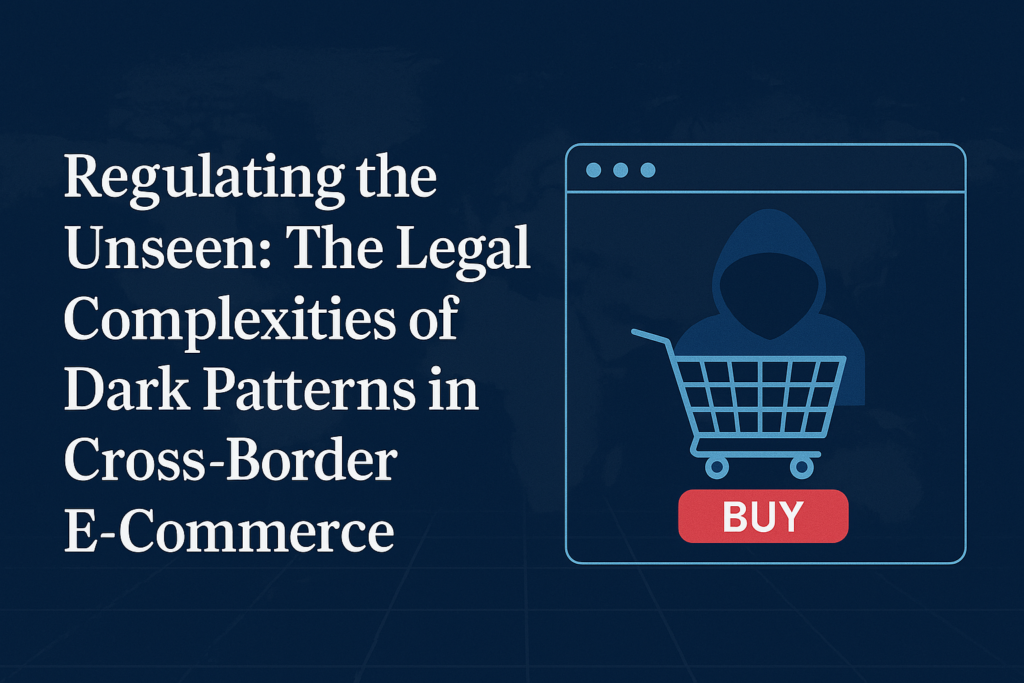
This article has been written by Krishna Patel, student of BBA-LLB, Auro University, Surat.

“Are you sure you want to leave?” “Only 2 left in stock – hurry!”
“Click here to claim your exclusive offer – expires in 5 minutes!”
If you’ve shopped online, chances are you’ve encountered these messages. They’re not just persuasive—they’re often manipulative. Welcome to the world of dark patterns.
What Are Dark Patterns?
Dark patterns are misleading design methods built into websites and applications that trick people into doing things they wouldn’t otherwise do—such as buying things on impulse, subscribing unknowingly to services, or revealing too much about themselves.
These strategies don’t depend on user decision—they use cognitive biases, friction, and ambiguity to nudge individuals into places that profit the business at the expense of the user.
Hidden Costs-
These are additional fees—such as shipping, taxes, or service charges—that don’t show up until the final checkout step. Users have already spent time shopping and adding products to their cart by the time they see the total price, so they’re more likely to just go through with the purchase to not have to start over elsewhere.
Why it’s a problem:
- It violates transparency, a fundamental tenant of consumer
- Consumers in other countries can also be charged currency conversion fees or hidden customs charges, so the ultimate price is even less certain.
Forced Continuity-
- This is the practice of providing a free trial (usually for a subscription product) that automatically becomes a paid plan without clearly telling the user or making it simple to cancel.
Why it’s bad:
- It takes advantage of forgetfulness and intentionally conceals exit
- In a cross-border environment, consumers might find it more difficult to contest global charges, and refund practices could vary by jurisdiction.
Confirm shaming-
- This is where a site employs shame-language to deter users from opting out. For instance, selecting “No thanks” could be labelled as “No thanks, I don’t care about my health.”
Why it’s problematic:
- It emotionally manipulates users into
- It blurs the line between marketing and coercion, which can be viewed as unfair or misleading advertising in most countries.
The Bigger Picture: Ethical and Legal Implications
Individually, these may seem like sneaky but harmless tricks. But collectively, they erode user trust and distort genuine consent—two pillars of ethical digital design.
In cross-border e-commerce, the problem is magnified because:
- Users are subject to different legal protections depending on where they
- Businesses may operate from countries with weaker consumer protection
- Enforcement agencies face jurisdictional limits, making it difficult to hold foreign platforms accountable.
The Cross-Border Challenge
One of the thorniest problems in policing dark patterns is this: e-commerce is international, but consumer protection regulation is not.
Consider this situation: a consumer in Germany shops on a site based in the United States, owned by a Singapore-headquartered company. If that consumer is tricked by a dark pattern—a false subscription trap, for example—whose law governs? And more to the point, who polices it?
This geographical disconnection generates a minefield of legal issues:
Jurisdictional Ambiguity
When a consumer is injured by a dark pattern, its frequently-unclear which nation’s legal system applies.
- Must the consumer’s country of origin laws apply?
- Or the laws of the company’s place of operations?
- Or those of the server’s location?
Most often, firms embed jurisdiction clauses in their terms and conditions, thereby compelling disputes to be heard in far-off, foreign courts—something most consumers will not fight.
One of the biggest challenges to governing dark patterns is this: the internet commerce world is global, but consumer protection legislation isn’t.
Picture it like this: a consumer in Germany buys through a site hosted in America by a firm headquartered in Singapore. If that consumer is deceived by a dark pattern—a bait-and- switch subscription trick, for instance—whose legislation governs? And more fundamentally, who governs them?
This geographic disconnection creates a field of legal niceties:
Key Legal Developments
Although the battle against dark patterns is only gaining worldwide traction, certain areas have already started taking tangible steps towards regulating misleading design practices— especially in online commerce.
Here’s a snapshot of how the legal landscape is changing: European Union: Setting the Standard
The EU has adopted a proactive and systematic approach to digital consumer protection:
- Digital Markets Act (DMA) and Digital Services Act (DSA): These historic regulations, which came into effect in 2023–2024, directly prohibit certain dark patterns employed by digital platforms, particularly those that have been labelled “gatekeepers” such as Google, Amazon, and Meta.
- Unfair Commercial Practices Directive: This directive already banned misleading and aggressive commercial practices—and now it’s being read to cover manipulative user interface design.
Why it matters
The EU’s clarity and enforcement tools are creating a global standard for ethical digital design. But enforcement remains limited to EU member states.
United States: Patchwork but Busy
The U.S. does not have a single federal law specifically aimed at dark patterns, but that does not equate to regulators doing nothing.
- The Federal Trade Commission (FTC) has openly warned businesses about dark patterns and enforced against deceptive practices related to subscriptions, consent, and
- A number of state-level legislations (such as California’s CCPA and CPRA) mandate clear opt-out processes and explicit consent—but fall short of tackling design deception in its
Why it matters
The U.S. regulatory style is piecemeal and reactive, with gaps that can be taken advantage of by shrewd platform operators—particularly those operating internationally.
In India: A New Player in Digital Consumer Rights
In 2023, India updated its Consumer Protection (E-Commerce) Rules, introducing clear language on “dark patterns” and deceptive advertisements.
- The rules feature bans on activities such as confirm shaming, bait-and-switch, and deceptive urgency indicators.
- penalties and compliance guidelines can be issued by the Central Consumer Protection Authority (CCPA).
Why it matters:
India is among the first large non-Western economies to call and codify dark patterns in law, paving the way for tougher enforcement in the Asia-Pacific.
The Catch: Local Laws, Global Internet
Even with these encouraging trends, there lies one fundamental constraint: Most of these laws have domestic application only.
That is to say that foreign companies can evade stricter regulation by establishing themselves in jurisdictions with poor enforcement or relaxed definitions. Dark patterns will continue to fall between the cracks of national laws until there’s a concerted international effort.
Why regulation is tricky?
Regulating dark patterns in cross-border e-commerce isn’t about simply drafting improved legislation—it’s an entangled mess of legal, technical, and ethical complexity.
Here’s a closer look at why regulation is so difficult:
Defining a Dark Pattern
Not all persuasive design is evil. The central problem is where to draw the line between:
- Ethical persuasion (such as nudging users toward healthy options), and
- Deceptive manipulation (such as manipulating users into spending more or sacrificing privacy).
Even in legal frameworks, this is a matter of personal opinion. What one regulator views as “manipulative,” another may interpret as innovative UX or run-of-the-mill marketing technique. This lack of clarity complicates the ability to craft laws that are both specific and enforceable.
The Pace of Tech Evolution
Technology and design techniques change more quickly than legal frameworks can respond.
- New patterns appear daily—from algorithmic nudging to AI-based
- Dark patterns hide in plain sight, hiding within UI/UX code or behind A/B testing
Regulations catch up too late and new loopholes have been discovered. This leads to a constant game of regulatory “whack-a-mole.”
Cultural Relativism
Design isn’t interpreted the same way everywhere. What might be considered deceptive or aggressive in one country could be culturally acceptable in another.
For example:
- In some markets, urgency cues like “Only 1 left!” may be seen as
- In others, they may be seen as exploitative or
This makes universal standards hard to agree on, especially in international frameworks where norms, expectations, and consumer literacy vary widely.
Lack of Harmonization
Currently, there’s no global treaty or shared legal framework specifically targeting dark patterns.
- Data protection laws like GDPR have some indirect influence, especially regarding consent and transparency.
- But when it comes to interface design manipulation, most countries act in isolation, if at all.
The result is a fragmented patchwork of rules—allowing companies to forum shop, operating from countries with the most relaxed regulations while targeting global consumers.
The Bottom Line
Dark patterns operate in the grey areas of legality, design, and culture. Regulating them requires more than enforcement—it demands clarity, cooperation, and continuous evolution.
Until then, consumers remain vulnerable to manipulation disguised as convenience—and regulators continue to play catch-up in an ever-shifting digital landscape.
What Needs to Change?
To effectively address the growing influence of dark patterns in cross-border e-commerce, we need more than just laws—we need a shift in how platforms, regulators, and users approach digital design.
Here’s what that change could look like:
- Global Coordination
Manipulative design is an international issue, and to address it will take international coordination.
- Regulators across the globe must develop mutual standards, define dark patterns in precise, enforceable language, and coordinate best practices.
- Arrangements for mutual enforcement—where one nation assists another’s consumer protections—would fill loopholes that exist.
Without cross-border cooperation, even the best domestic legislation will be unable to make a significant impact.
- Platform Accountability
Large e-commerce platforms such as Amazon, Alibaba, and Shopify feature millions of third- party sellers—yet they regularly avoid accountability for how those sellers structure their user flows.
- The platforms must be made to review and moderate exploitative design tactics, not only user content.
- Responsibility should be extended to default UI templates, inbuilt nudges, and dark pattern plugins employed on their platforms.
If the platform benefits from the deception, they should also take responsibility for preventing it.
- Transparency Tools & Ethical Design
Designers and developers must embrace a “privacy and transparency by design” approach.
- Provide simple, plain options for opt-outs, consent, and
- Prevent pre-ticked boxes, ambiguous button placement, or covert
- Implement open-source software or third-party audits to ensure designs are of ethical Ethical UX isn’t simply good for users—it establishes long-term trust and brand reputation.
- Digital Literacy
At the end of the day, users are the first line of defense.
- Educating consumers about dark patterns—how they work, what to look for, and how to push back—is essential.
- Schools, advocacy groups, and even browser extensions can help people recognize red flags and make informed choices online.
A well-informed user is less likely to be manipulated, and more likely to demand accountability.
The Path Forward
Combating dark patterns isn’t about restricting innovation—it’s about making the digital world fairer, safer, and more transparent for everyone. Whether through better regulation, ethical design, or empowered users, the solution lies in a coordinated, global response.
Dark patterns may be invisible at first glance, but their effects ripple through the digital marketplace—eroding trust, distorting consent, and quietly exploiting millions of consumers every day. As global e-commerce continues to expand, so does the urgency for a coordinated, cross-border legal response that can hold manipulative design to account. Without it, the most vulnerable users remain unprotected, and ethical businesses are left competing in an uneven playing field. Until that framework emerges, the battle to regulate the unseen continues—one deceptive click at a time.
References:
- https://consumeraffairs.nic.in/sites/default/files/file- uploads/latestnews/Draft%20Guidelines%20for%20Prevention%20and%20Regulation%20of%20Dark%20Patterns%202023.pdf
- https://pib.gov.in/PressReleaseIframePage.aspx?PRID=1983994
- https://securityaffairs.com/175223/security/cybersecurity-challenges-in-cross-border-data- transfers-and-regulatory-compliance-strategies.html
- https://www.thehindu.com/business/Industry/dark-patterns-pose-a-growing-concern-in- indias-digital-landscape/article68634686.ece






